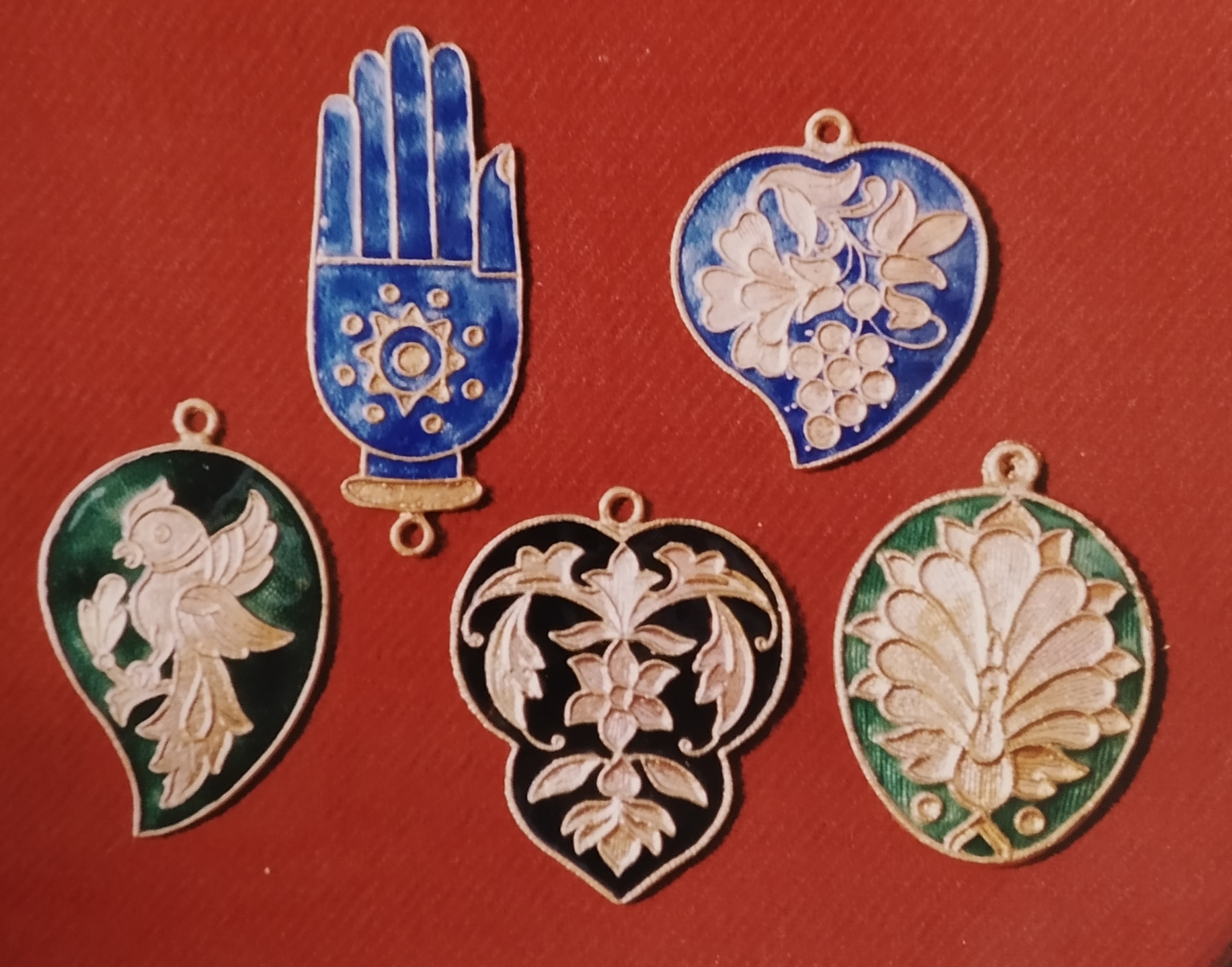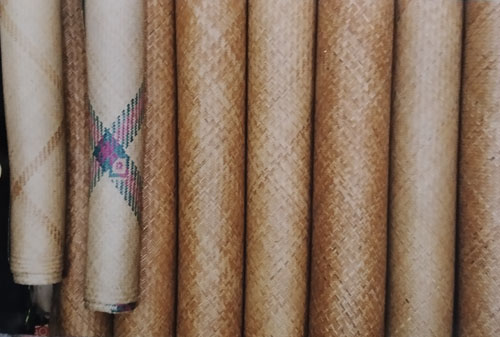Enameling or minakari can be described as the art of coloring and ornamenting the surface of metals by fusing over it brilliant colors that are patterned in an intricate design. Enamel or mina work was a notable Mughal innovation in metal craft. Mina was popular both with the Mughals and the Hindu princes of Rajasthan where it was used for enriching jewelry and for creating other precious objects.
Using a variety of colors the craftspersons ornament the surface of the metal. Gold has traditionally been used for minakari jewelry as its luster brings out the colors of the enamels; it also holds the enamel better and lasts longer. Silver is a later introduction and is used for artifacts like boxes, bowls, spoons, and art pieces. Copper, which is used for handicraft products, was introduced only after the Gold Control Act — which compelled the minakars to look for a material other than gold — was enforced in India.
The work of the minakar often went unnoticed as, traditionally, minakari patterns were used basically as a backing for the famous kundan or stone-studded jewellery. Several reasons were cited to explain this: the prosaic explanation was that it allowed the wearer to reverse the jewellery, while the more poetic reason was that the wearer of the jewellery was promised a special joy in the secret of the hidden design!
The minakars belong to the Sonar or Soni caste of kshatriyas and identify themselves with the name of Minakar or Verma. This is a hereditary craft and the minakars seldom allow outsiders to acquire any knowledge of their craft. The process followed is long and complex and a single piece of mina can pass through many hands before it is completed. The traditional sequence starts with the designer (nacquash, chitera), and moves on to the goldsmith (sonar, swarnakar), the engraver who engraves the design (kalamkar, khodnakar), the enamellist who applies the colour (minakar), the polisher (ghotnawala, chiknawala), the stone-setter (jadia, kundansaaz), and the stringer (patua), all of whom are part of the chain that creates the finished product. However, often a single artisan performs a multiplicity of tasks.
Like a miniature artist, the minakar engraves the surface of the metal with intricate designs using a metal stylus. This is then filled in with colors. When placed in a furnace, the colors fuse and harden to become one with the surface. The piece is then gently rubbed with a file and cleaned with a mixture of lemon and tamarind, which helps emphasize the brilliance of each color. Enamel colors are metal oxides mixed with a frit of finely powdered glass; the shade obtained varies according to the amount of oxide added and the powder is suspended in water for ease of application. The color yellow is obtained through the use of chromate of potash, violet through carbonate of manganese, blue through cobalt oxide, green through copper oxide, brown through red oxide, and black through manganese, iron, and cobalt. The brilliant red is the most difficult of colors to achieve. White and ivory, also difficult, are achieved through a mix of antinomies of potash, hydrated iron oxide, and carbonate of zinc. The minakar applies the color according to their level of hardness, beginning with the hardest. Before the enamel is applied the surface of the ornament is carefully cleaned. In their raw form these mixtures do not always show their true colors, which emerge only when they are fired in the kiln. The average firing temperature is about 850 degrees Celsius. The enamel colors are bought either from Amritsar in Punjab or from Germany or France.
Enameling was earlier practiced in many centers in India, with each region specializing in its own variation of style and technique. In Lucknow the speciality of the minakars was blue and green enamelling on silver, while in Banaras the dusky rose-pink or the gulabi mina was the dominant colour. The craft was also practised in Kangra, Kashmir, and Bhawalpur. It was, however, most vibrant in Jaipur (Rajasthan) and in Delhi, and these two centres continue to create minakari pieces of excellence till today.
The family members of Ram Krishan Minakar, a master craftsman and a National Award winner based in Delhi state that the craft of minakari has been handed down for at least four generations, if not longer. The children, too, are interested in following the family tradition. Ram Krishan’s family today works with a copper and brass alloy to make handicraft items that are sold all over the country and even exported. They are one of the few minakar families who work with this alloy. They traditionally worked with gold till the Gold Control Act was introduced in India and it became hard if not impossible to access Gold, through design innovation and adapting of technique the family honed this new technique. The mix of the alloy is a closely guarded family secret.
In Delhi and Jaipur two forms of enamelling are popular: the champlevé style where the metal is engraved to create depressions into which colour is embedded; and the repoussé form in which a thin metal plate is embossed over a prefabricated die. This die has the design etched on one of its sides. The metal plate is moulded over the die by stamping on it. Once this is done the grooves are etched with the help of a metal stylus and the colours filled into the areas created. A metal stylus with its front flattened and shaped like a wedge is used for carving and engraving the base metal. The mina is powdered before use with a grinder and is dispersed with a metal spatula into the palette. Long pointed needles of different thicknesses are used for applying the colour on the carved or moulded metal plate. Blocks are used both for engraving and for embossing the metal plate. The kiln is an essential part of the process and can range from a relatively modern to a homemade one. Tools for the final cleaning of the piece include an iron needle and a file. The design vocabulary in minakari is vast and includes many patterns. Creepers and vines, flowers (particularly the lotus), birds (especially the parrot and the peacock), paisleys, geometric patterns, and calligraphy are some of the more commonly used designs. The colours used are red, green, white, and blue.
In its contemporary form, minakari is not confined to traditional jewellery but ranges into more ‘modern’ products, often with a copper base, including bowls, ashtrays, key chains, vases, spoons, figures of deities, and wall pieces.
Gallery
YOUR VIEWS
PRACTITIONERS: INDIA
Access 70,000+ practitioners in 2500+ crafts across India.
BIBLIOGRAPHY
10,000+ listings on arts, crafts, design, heritage, culture etc.
GLOSSARY
Rich and often unfamiliar vocabulary of crafts and textiles.
SHOP at India InCH
Needs to be written.






